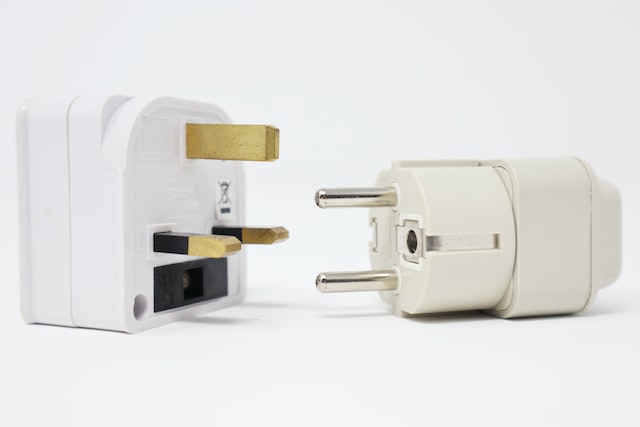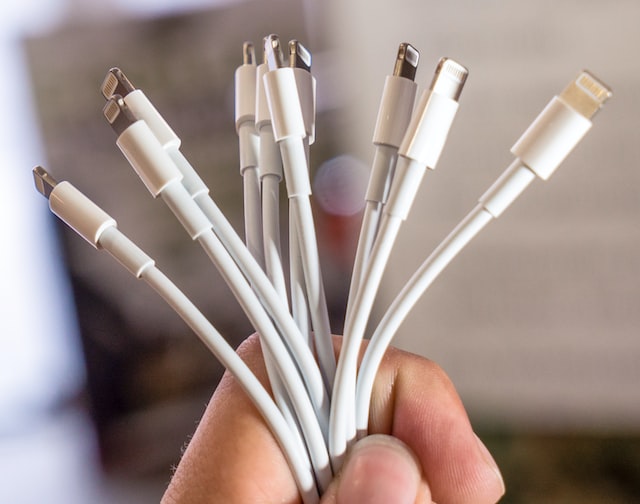An adapter is a device that helps two incompatible devices work together. A connector is a device that helps two compatible devices work together.
Adapters
(Photo by Call Me Fred on Unsplash )

An adapter is a device that helps two pieces of equipment to work together even if they are not originally compatible. Adapters allow you to connect two different types of devices. adapters can connect both electrical and electronic devices. Electrical adapters are used to connect two pieces of equipment that use different voltages, while electronic adapters are used to connect two pieces of equipment that use different signals.
Adapters are used to change the physical form of a signal so that it can be used with another device. For example, you might use an adapter to convert a digital signal to an analog signal, or vice versa. You might also use an adapter to change the voltage level of a signal so that it’s compatible with another device.
Connectors
(Photo by Mika Baumeister on Unsplash )

A connector is a device that is used to connect two or more pieces of equipment. connectors allow you to connect two similar devices. Connectors are used to join two wires or cables together. This can be done in a permanent or temporary way. For example, you might use a connector to join two pieces of audio equipment together or to connect a cable to an electrical outlet.
Are connectors and adapters the same?
If you’re new to the world of electronics, you might be wondering what the difference is between an adapter and a connector. Both are essential components in many electronic devices, but they serve different purposes.
Adapters and connectors are two types of hardware devices that are used to connect computing devices together. Adapters usually connect two devices that use different types of connectors, while connectors are typically used to connect two devices that use the same type of connector.
What is the difference between an adapter and a connector?
An adapter and a connector are both types of devices used to connect two different components or systems, but they differ in their functionality and design.
A connector is a device that is designed to join two separate components or systems, usually by providing a secure and stable physical connection between them. Connectors are often designed to be highly reliable and durable, with strong and secure attachment mechanisms that can withstand repeated use and heavy loads. Examples of connectors include USB cables, Ethernet cables, and audio cables, which are used to connect computers, networking devices, and audio equipment.
An adapter, on the other hand, is a device that is used to connect two components or systems that would not otherwise be compatible. Adapters typically have different types of connectors or interfaces on each end, allowing them to bridge the gap between different systems. Adapters may also be used to change the size or shape of a connector, allowing it to fit into a different type of port or socket. Examples of adapters include HDMI to VGA adapters, USB-C to USB-A adapters, and AC power adapters, which allow you to use devices with different types of connectors or power requirements.
The main difference between an adapter and a connector is that a connector is designed to provide a secure physical connection between two components or systems, while an adapter is designed to allow two incompatible components or systems to be connected by providing a bridge between them.
What are the key differences between adapters and connectors?
Adapters and connectors are both used to connect two components or systems, but they differ in several key ways:
Compatibility: Connectors are typically designed to be compatible with specific types of ports or sockets, such as USB, Ethernet, or audio ports. Adapters, on the other hand, may be used to change the size or shape of a connector, allowing it to fit into a different type of port or socket.
Function: Connectors are designed to join two separate components or systems by providing a secure and stable physical connection between them. Adapters, on the other hand, are used to connect two components or systems that would not otherwise be compatible.
Versatility: Adapters are generally more versatile than connectors, as they can be used to connect a wide range of devices with different types of ports or connectors. Connectors, on the other hand, are typically limited to specific types of devices or systems.
Design: Connectors are typically designed to be highly reliable and durable, with strong and secure attachment mechanisms that can withstand repeated use and heavy loads. Adapters, on the other hand, typically have different types of connectors or interfaces on each end, allowing them to bridge the gap between different systems.
What are the different types of adapters?
There are many different types of adapters available, each with a specific purpose and set of compatible devices. Here are some examples of different types of adapters and their uses:
- HDMI to VGA adapter: This type of adapter allows you to connect an HDMI output to a VGA input, which is useful for connecting modern computers or media devices to older displays that only have VGA inputs.
- USB-C to USB-A adapter: This type of adapter allows you to connect a USB-C device to a USB-A port, which is useful for connecting newer devices to older computers or charging blocks that only have USB-A ports.
- DisplayPort to HDMI adapter: This type of adapter allows you to connect a DisplayPort output to an HDMI input, which is useful for connecting modern computers or media devices to older displays that only have HDMI inputs.
- Lightning to 3.5mm headphone jack adapter: This type of adapter allows you to connect headphones or other audio equipment with a 3.5mm headphone jack to newer Apple devices that only have Lightning ports.
- Ethernet to USB adapter: This type of adapter allows you to connect a computer or other device that only has a USB port to an Ethernet network, which is useful for getting a wired network connection on a device that doesn’t have an Ethernet port.
- AC power adapter: This type of adapter allows you to power a device that requires a specific type of power input, such as a laptop or a phone charger.
- SIM card adapter: This type of adapter allows you to use a SIM card of a different size in a device that requires a specific size of SIM card, such as using a nano-SIM card in a device that requires a micro-SIM card.
Adapters come in many different types and sizes and are used for a wide range of purposes, from connecting different types of display outputs to powering devices that require specific types of power inputs. The right adapter for your needs will depend on the specific devices and ports you are working with.
What are the different types of connectors?
Connectors come in a variety of shapes, sizes, and types to fit different applications and needs. Here are some examples of different types of connectors and their uses:
- USB Type-A connector: This is a rectangular connector with four contacts that is commonly used to connect peripherals, such as mice, keyboards, and flash drives, to computers.
- USB Type-C connector: This is a small, reversible connector that is becoming increasingly popular for a wide range of devices, including laptops, smartphones, and other electronics.
- HDMI connector: This is a compact, high-bandwidth connector that is used to transmit high-quality video and audio signals between devices, such as televisions, media players, and computers.
- DisplayPort connector: This is a digital display interface that is used to transmit video and audio signals between computers and displays, such as monitors or projectors.
- 3.5mm audio connector: This is a small, round connector that is used to transmit audio signals from devices such as headphones, speakers, and microphones.
- Ethernet connector: This is a rectangular connector that is used to connect computers and other devices to a wired network.
- RCA connector: This is a connector that is used to transmit analog video and audio signals, and is commonly used to connect DVD players, TVs, and other home theater equipment.
- Coaxial connector: This is a connector that is used to transmit high-frequency signals, such as those used in cable and satellite TV systems.
- BNC connector: This is a connector that is commonly used in professional audio and video equipment, as well as in network and telecommunications equipment.
Connectors come in a wide range of types and sizes, each with specific uses and applications. Choosing the right connector for a particular device or system requires careful consideration of the device’s needs and specifications.
What are the Advantages and disadvantages of adapters?
Adapters have some advantages and disadvantages, depending on the specific use case. Here are some examples:
Advantages of adapters:
- Cost-effective: Adapters are often a more affordable solution than purchasing new equipment or upgrading existing systems.
- Improved compatibility: Adapters can help to bridge the gap between devices that use different connectors or interfaces, allowing them to work together seamlessly.
- Portability: Adapters are generally small and lightweight, making them easy to transport and use on the go.
Disadvantages of adapters:
- Reduced reliability: Adapters can introduce additional points of failure in a system, which may result in decreased reliability or performance.
- Reduced signal quality: Adapters can sometimes degrade the quality of a signal, particularly for high-bandwidth applications such as video or audio transmission.
- Compatibility limitations: Some devices may not be compatible with certain types of adapters, or may require additional configuration or setup to work properly.
- Physical limitations: Some adapters may be bulky or difficult to use in certain environments, such as in tight spaces or on mobile devices with limited ports.
While adapters can be a cost-effective and convenient solution for connecting different types of devices, they also come with some potential downsides. Careful consideration of factors such as cost, compatibility, and reliability is important when determining whether to use an adapter or seek out an alternative solution.
What are the Advantages and disadvantages of connectors?
Connectors also have some advantages and disadvantages, depending on the specific use case. Here are some examples:
Advantages of connectors:
- Ease of use: Connectors are generally designed to be easy to use, with a simple plug-and-play interface that requires no additional setup or configuration.
- High signal quality: Connectors are often engineered to provide high-quality signal transmission, with minimal loss or degradation of the signal.
- Durability: Connectors are typically made from high-quality materials and designed to withstand frequent use, making them a reliable solution for many different applications.
Disadvantages of connectors:
- Cost: Connectors can be more expensive than some other types of interconnect solutions, particularly for high-end or specialized applications.
- Compatibility limitations: Connectors may not be compatible with all devices or systems, which can limit their usefulness in certain contexts.
- Physical limitations: Some types of connectors may be bulky or difficult to use in certain environments, such as in tight spaces or on mobile devices with limited ports.
- Complexity: Some types of connectors may require additional setup or configuration to work properly, which can be time-consuming and may require technical expertise.
Connectors can provide high-quality, reliable connections between devices, they also come with some potential downsides, including cost, compatibility limitations, and complexity. It’s important to carefully consider the specific requirements of a given application to determine whether a connector is the best solution or whether an alternative approach, such as an adapter or wireless connection, may be more appropriate.
How to choose the right adapter or connector?
Choosing the right adapter or connector is critical to ensure reliable and efficient connectivity between devices. There are several factors to consider when selecting the right adapter or connector for a given situation, including compatibility, performance, and cost.
First and foremost, it is important to consider the compatibility of the adapter or connector with the devices or systems being connected. This includes not only physical compatibility, but also compatibility with the relevant communication protocols or interfaces. It’s important to research the specific requirements of the devices or systems involved, and to select an adapter or connector that is fully compatible.
In addition to compatibility, performance is another key factor to consider when choosing an adapter or connector. This includes considerations such as signal quality, bandwidth, and latency. It’s important to select an adapter or connector that can provide the necessary performance for the specific application or use case.
Cost is also an important consideration when selecting an adapter or connector. While it may be tempting to opt for the cheapest solution, it’s important to balance cost with other factors such as reliability and performance. A more expensive adapter or connector may be a worthwhile investment if it provides greater performance, reliability, or compatibility.
Other factors to consider when selecting an adapter or connector include durability, ease of use, and scalability. It’s important to select a solution that can withstand frequent use and will not need to be frequently replaced, and that is easy to set up and use in a variety of environments. Scalability is also important, as the solution should be able to grow and adapt as the needs of the organization or application change over time.
Choosing the right adapter or connector requires careful consideration of several key factors, including compatibility, performance, cost, durability, ease of use, and scalability. By taking the time to research and evaluate different options, it is possible to select a solution that provides reliable, high-performance connectivity for a wide range of applications and use cases.
Featured Image By – Claudio Schwarz on Unsplash









